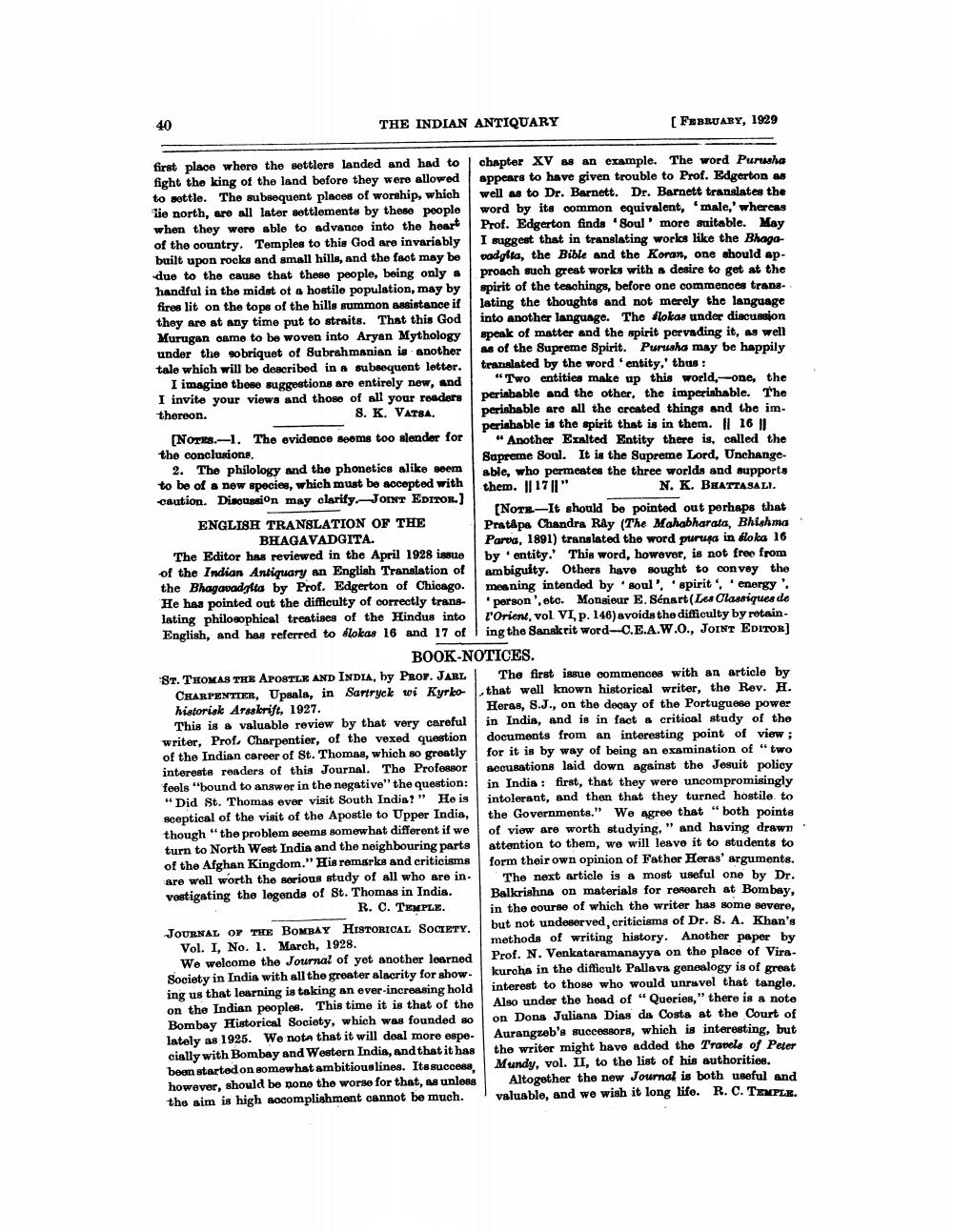________________
40
THE INDIAN ANTIQUARY
first place where the settlers landed and had to fight the king of the land before they were allowed to settle. The subsequent places of worship, which lie north, are all later settlements by these people when they were able to advance into the heart of the country. Temples to this God are invariably built upon rocks and small hills, and the fact may be due to the cause that these people, being only a handful in the midst of a hostile population, may by fires lit on the tops of the hills summon assistance if they are at any time put to straits. That this God Murugan came to be woven into Aryan Mythology under the sobriquet of Subrahmanian is another tale which will be described in a subsequent letter. I imagine these suggestions are entirely new, and I invite your views and those of all your readers 8. K. VATSA.
thereon.
[NOTES.-1. The evidence seems too slender for the conclusions.
2. The philology and the phonetics alike seem to be of a new species, which must be accepted with caution. Discussion may clarify.-JOINT EDITOR.]
ENGLISH TRANSLATION OF THE BHAGAVADGITA.
The Editor has reviewed in the April 1928 issue of the Indian Antiquary an English Translation of the Bhagavadgita by Prof. Edgerton of Chicago. He has pointed out the difficulty of correctly translating philosophical treatises of the Hindus into English, and has referred to slokas 16 and 17 of
[ FEBRUARY, 1929
This is a valuable review by that very careful writer, Prof. Charpentier, of the vexed question of the Indian career of St. Thomas, which so greatly interests readers of this Journal. The Professor feels "bound to answer in the negative" the question: "Did St. Thomas ever visit South India?" He is sceptical of the visit of the Apostle to Upper India, though "the problem seems somewhat different if we turn to North West India and the neighbouring parts of the Afghan Kingdom." His remarks and criticisms are well worth the serious study of all who are in. vestigating the legends of St. Thomas in India. R. C. TEMPLE. JOURNAL OF THE BOMBAY HISTORICAL SOCIETY. Vol. I, No. 1. March, 1928. We welcome the Journal of yet another learned Society in India with all the greater alacrity for show. ing us that learning is taking an ever-increasing hold on the Indian peoples. This time it is that of the Bombay Historical Society, which was founded so lately as 1925. We note that it will deal more especially with Bombay and Western India, and that it has been started on somewhat ambitious lines. Its success, however, should be none the worse for that, as unless the aim is high accomplishment cannot be much.
chapter XV as an example. The word Purusha appears to have given trouble to Prof. Edgerton as well as to Dr. Barnett. Dr. Barnett translates the word by its common equivalent, male,' whereas Prof. Edgerton finds 'Soul' more suitable. May I suggest that in translating works like the Bhagavadgita, the Bible and the Koran, one should approach such great works with a desire to get at the spirit of the teachings, before one commences trans. lating the thoughts and not merely the language into another language. The slokas under discussion speak of matter and the spirit pervading it, as well as of the Supreme Spirit. Purusha may be happily translated by the word entity,' thus:
"Two entities make up this world,-one, the perishable and the other, the imperishable. The perishable are all the created things and the imperishable is the spirit that is in them. || 16 ||
"Another Exalted Entity there is, called the Supreme Soul. It is the Supreme Lord, Unchange. able, who permeates the three worlds and supports them. ||17||" N. K. BHATTASALI. [NOTE-It should be pointed out perhaps that Pratapa Chandra Rây (The Mahabharata, Bhishma Parva, 1891) translated the word purusa in sloka 16 by entity. This word, however, is not free from ambiguity. Others have sought to convey the meaning intended by soul', 'spirit, energy'. 'person', etc. Monsieur E. Sénart (Les Classiques de l'Orient, vol VI, p. 146) avoids the difficulty by retain ing the Sanskrit word-C.E.A.W.O., JOINT EDITOR]
BOOK-NOTICES.
ST. THOMAS THE APOSTLE AND INDIA, by PROF. JARL The first issue commences with an article by CHARPENTIER, Upsala, in Sartryck wi Kyrko-that well known historical writer, the Rev. H. Heras, S.J., on the decay of the Portuguese power historisk Arsskrift, 1927. in India, and is in fact a critical study of the documents from an interesting point of view; for it is by way of being an examination of "two accusations laid down against the Jesuit policy in India: first, that they were uncompromisingly intolerant, and then that they turned hostile to the Governments." We agree that "both points of view are worth studying," and having drawn attention to them, we will leave it to students to form their own opinion of Father Heras' arguments.
The next article is a most useful one by Dr. Balkrishna on materials for research at Bombay, in the course of which the writer has some severe, but not undeserved, criticisms of Dr. S. A. Khan's methods of writing history. Another paper by Prof. N. Venkataramanayya on the place of Virakurcha in the difficult Pallava genealogy is of great interest to those who would unravel that tangle. Also under the head of "Queries," there is a note on Dona Juliana Dias da Costa at the Court of Aurangzeb's successors, which is interesting, but the writer might have added the Travels of Peter Mundy, vol. II, to the list of his authorities.
Altogether the new Journal is both useful and valuable, and we wish it long life. R. C. TEMPLE.




